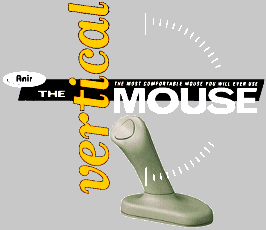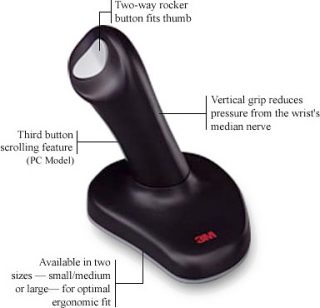2000: The innovative, leaning joystick-shaped, Animax Dr. Mouse/Anir Mouse from Norway is a simple idea: a pistol-grip on top of a conventional, albeit flattened, mouse base, with a thumb-button for clicking.
 Unlike conventional mice, which force your hand and forearm to assume a stressed, unnatural, flattened attitude, Dr. Mouse allows your hand to remain in a relaxed, thumb-uppermost posture, which reduces muscle loading and relieves pressure on the median nerve.
Unlike conventional mice, which force your hand and forearm to assume a stressed, unnatural, flattened attitude, Dr. Mouse allows your hand to remain in a relaxed, thumb-uppermost posture, which reduces muscle loading and relieves pressure on the median nerve.
Mouse movement with Dr. Mouse is accomplished by sweeping forearm movements rather than wrist flexing, and the thumb, your strongest digit, takes over button-clicking tasks. I don’t suffer from carpal tunnel syndrome, but I do have peripheral neuritis, and it stands to reason that a mouse that reduces stress on the wrist would benefit those who do have CTS as well.
In an extensive study of Repetitive Strain Injury (RSI) and other computer-related medical complaints among its employees, Alcatel STK found that the Dr. Mouse/Anir Mouse reduced injury-related absenteeism. “The results are surprisingly good. We have demonstrated a drastic reduction of pain in the shoulders, underarm, wrists, and hands in the group which has used the Anir Vertical mouse. In addition, the incidence of headaches and illness-related absenteeism has fallen significantly,” says Alcatel’s senior company medical officer, Dr. Arne Aarås.

The iMac version has USB.
I have been using Dr. Mouse for about a year now, alternating with my other favorite mouse – a Macally two-button unit. I find that switching back and forth between the two types of mice keeps stress on one part of my hand from building up. I also have found that gripping the handle loosely with the ends of my fingers is more comfortable than making a fist-grip.
Dr. Mouse features include:
- Two buttons
- Users rest the back of the hand at the base of the mouse and the thumb on the switch on top of the stick for easy right and left clicks of the button
- Muscle strain on the forearm is much lower than with a conventional mouse
- 2 year limited warranty
- Requires only slight flexing of the wrist and slight twisting of the hand, resulting in less pressure in the carpal tunnel area for greater comfort
- Heavy mouse ball with silicon coating for precise cursor movement
- Maximum resolution: 400 dpi
Dr. Mouse does take some getting used to compared with conventional mice. As the Animax people put it:
- 1st day: You’ll hate it; it’s very different from what you’re used to.
- 2nd day: You’ll still hate it, but you’re beginning to forget your old mouse habits.
- 3rd day: You’ll love it, and you’ll never want to use anything else ever again
Actually, I liked Dr. Mouse from the start, although I was a bit clumsy mousing with it at first. The relief from pain at the base of my index and big fingers made Dr. Mouse easy to make friends with. By the end of day two, I was getting the hang of it, and by the third day, it was becoming second nature. I now have no problem switching back and forth – sort of like going from a manual shift car to an automatic and back again.
Mousing in the thumb-up position does not feel quite as direct and precise as with a conventional mouse, and people who do critical onscreen work might not find Dr. Mouse an adequate solution (although it does resolve a respectable 400 dpi). Sweeping forearm movements from the elbow are not quite the ideal body-English for picking out individual tiny pixels. However, for word processing, finder navigation, and web work, there should be no problem adapting to this device. In fact, I find it so comfortable that I often mouse-click rather than use keyboard commands for many tasks.
Dr. Mouse is available in both conventional Mac ADB and USB configurations, and in two sizes. The large size fits hands measuring 3.5″ to 4″ across the palm of your hand at the base of your fingers (where your four fingers meet your palm). The Medium size is for persons with hands measuring 2.75″ to 3.5″. There is no left-handed version available as yet. The model I have is the large size, and although my hand measures only about 3.5″, I found it none too large for a snug grip, but since, as noted above, I tend to drape my hand loosely over the upright handgrip anyway, so for me, at least, the size of the mouse would not be a critical consideration. My thumb falls nicely and naturally on the mouse button.

Since this review was first published, the 3M Renaissance Mouse has replaced the Anir Mouse.
Which brings me to the thing I miss using Dr. Mouse instead of the Macally 2-button programmable mouse. While I can assign either button on the Macally mouse to emulate any keystroke (I leave the left button as a standard mouse click, while the right usually emulates the “return” key), Dr. Mouse, at least in the ADB version, is not programmable. The mouse button is a two-position rocker, with the left or down click working as a normal mouse click, while the right or up click is a click-lock allowing you to drag icons around, for instance, or hold menus open without holding the mouse button down. While this can be convenient, I really miss that “return” click.
The advantage of non-programmability is that the ADB Dr. Mouse needs no special mouse driver extension. According to Animax’s Bill Handel,
“The Mac product was designed so that it communicates directly with the operating system. Upon boot up the system polls the mouse port and our mouse provides an ‘M: class’ code, which tells the CPU it is a mouse and the drivers are in the firmware of the mouse.”
Conversely, the PC version of Dr. Mouse requires drivers, and some PC models even have a third button, as well as being programmable. I think Animax should at least offer a programmable driver for the Mac version as an option, although not having to use a dedicated driver has the advantage of simplicity.
Dr. Mouse was developed in Norway, where it is known as the Anir Mouse, and I found the English documentation to be a bit cryptic and the PC-feature instructions included with my Mac test mouse might have confused the average consumer since none of them pertain to the Mac.
However, the product itself is solid innovation. If you suffer from hand, wrist, or arm pain from using a mouse, you really owe it to yourself (and your body) to try Dr. Mouse.
Miscellaneous Ramblings Rating: 4-1/2 out of 5
Cool
- Extremely comfortable to use
- Delivers on its advertising promises
- Well made of high-quality materials an components
Needs Some Work
- An optional, programmable driver for the Mac version would be nice
- English documentation is minimal and confusing
Where to Buy
- The 3M Ergonomic Optical Mouse has replaced the Anir Mouse. Depending on size, the USB/PS2 version is $55.76-$62.00 from Amazon.com, the wireless version, $74.00-$74.23.
keywords: #ergonomicmouse

